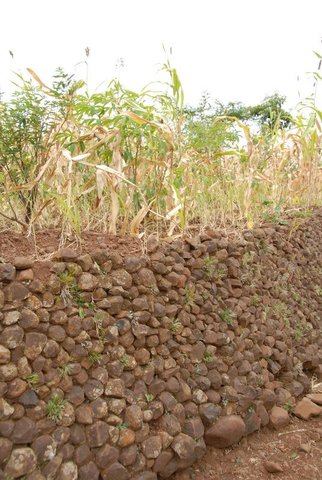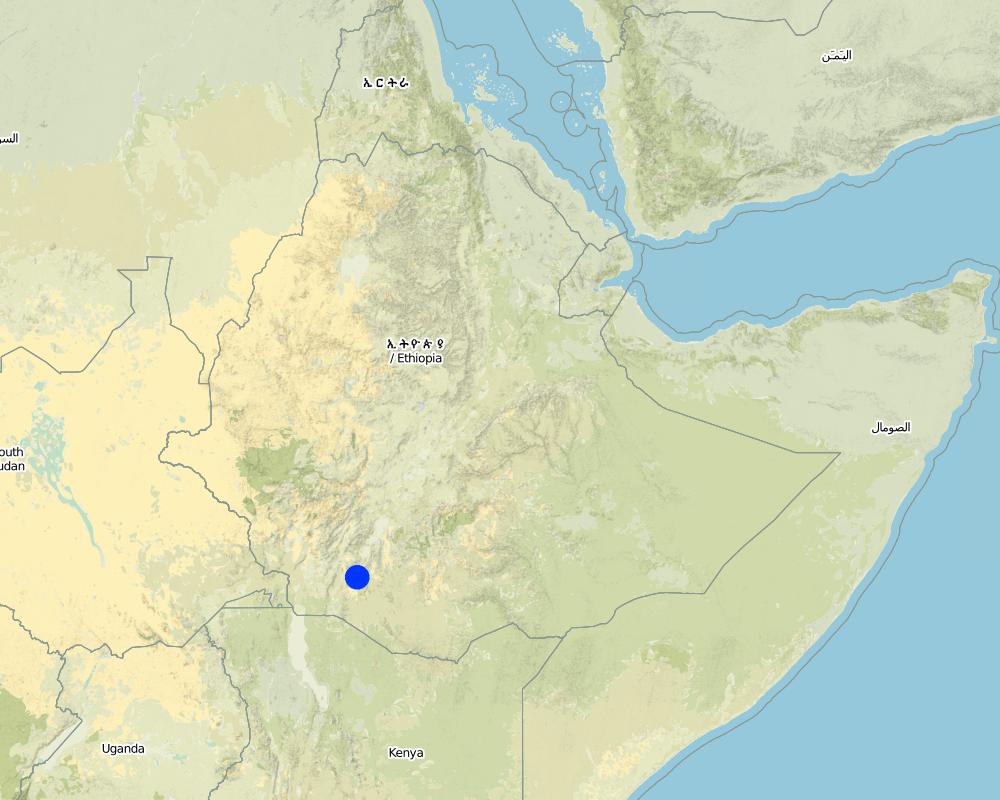Labour exchange [เอธิโอเปีย]
- ผู้สร้างสรรค์:
- การอัพเดท:
- ผู้รวบรวม: Unknown User
- ผู้เรียบเรียง: –
- ผู้ตรวจสอบ: Fabian Ottiger
approaches_2674 - เอธิโอเปีย
ดูส่วนย่อย
ขยายทั้งหมด ย่อทั้งหมด1. ข้อมูลทั่วไป
1.2 รายละเอียดที่ติดต่อได้ของผู้รวบรวมและองค์กรที่เกี่ยวข้องในการประเมินและการจัดเตรียมทำเอกสารของแนวทาง
1.3 เงื่อนไขที่เกี่ยวข้องกับการใช้ข้อมูลที่ได้บันทึกไว้ผ่านทาง WOCAT
ผู้รวบรวมและวิทยากรหลักยอมรับเงื่อนไขเกี่ยวกับการใช้ข้อมูลที่ถูกบันทึกผ่านทาง WOCAT:
ใช่
1.4 การอ้างอิงถึงแบบสอบถามเรื่องเทคโนโลยี SLM

Terrasses en banquettes Konso [เอธิโอเปีย]
Un talus en pierres selon les courbes du niveau en nivelant progressivement la terre entre deux niveaux afin de contrôler l'érosion du sol.
- ผู้รวบรวม: Daniel Danano
2. คำอธิบายของแนวทาง SLM
2.1 การอธิบายแบบสั้น ๆ ของแนวทาง
It is an approach based on labour exchange organized on the basis of mutual assistance involving no payment for work done. However, the land user is supposed to provide people participating with food and drinks. All wanting such cooperation request the me
2.2 การอธิบายอย่างละเอียดของแนวทาง
การอธิบายอย่างละเอียดของแนวทาง:
Aims / objectives: To alleviate the labour shotage each member of the labour exchange group could request for assistance any time farm activities need to be performed. The objective of the approach is to strengthen the relationship among the community members. It is further intended to make the community members share experience, skills and technical know-how on soil and water conservation activities.
Role of stakeholders: A farmer request individuals from the community members to get support.The request is made ahead of time in informing individual farmers about the programme (one to two weeks ahead) so that participants get enough time to prepare. The farmer who seeks assistance should prepare food and local drinks. And in the mean time, the farmer has to remind those who are requested for help so that all invited farmers participate. The participants avail themselves on the specified date with all necessary farm implements required for the activity. In this approach particularly for soil and water conservation activities participants shold be men. For weeding and harvesting women involve more than men because they can carry more weights than men.
2.5 ประเทศ ภูมิภาค หรือสถานที่ตั้งที่ได้นำแนวทางไปใช้
ประเทศ:
เอธิโอเปีย
ภูมิภาค/รัฐ/จังหวัด: :
Konso, SNNPR
Map
×2.7 ประเภทของแนวทาง
- แบบดั้งเดิม/ แบบพื้นเมิอง
2.8 เป้าหมายหรือวัตถุประสงค์หลักของแนวทาง
The Approach focused mainly on other activities than SLM (Approach is used mostly on activites like land preparation, sowing and weeding. Community members help each other in contributing labour contributing labour on the basis of mutual understanding)
To solve the labour constraints faced by that some members of the community.
The SLM Approach addressed the following problems: Shortage of labour
2.9 เงื่อนไขที่เอื้ออำนวยหรือเป็นอุปสรรคต่อการนำเทคโนโลยีภายใต้แนวทางนี้ไปปฏิบัติใช้
การมีไว้ให้หรือการเข้าถึงแหล่งการเงินและบริการ
- เป็นอุปสรรค
Lack of finance to hire labour
Treatment through the SLM Approach:
กรอบแนวทางในการดำเนินการด้านกฎหมาย (การถือครองที่ดิน สิทธิในการใช้ที่ดินและน้ำ)
- เอื้ออำนวย
The practice has been there before the existing land ownership policy came into existance and it still exists after it.
อื่นๆ
- เป็นอุปสรรค
Shortage of grain. A farmer to benefit from labour exchange he has to have enough food crop in which he can make food and drink.
Treatment through the SLM Approach:
3. การมีส่วนร่วมและบทบาทของผู้มีส่วนได้ส่วนเสียที่เกี่ยวข้อง
3.1 ผู้มีส่วนได้ส่วนเสียที่เกี่ยวข้องในแนวทางนี้และบทบาท
- ผู้ใช้ที่ดินระดับท้องถิ่นหรือชุมชนระดับท้องถิ่น
Men mainly undertake SWC activities but women equally take part in other farm activities.
According to the farmers view men are wise (have more wisdom on indegenous technical knowledge than women). The SWC work is tedious and requires more energy to perform. No significant difference among different classes or status in the community in dicision making because the approach is mainly designed to help those who require labour assisstance for their farm activities.
3.2 การเกี่ยวข้องของผู้ใช้ที่ดินระดับท้องถิ่นหรือชุมชนระดับท้องถิ่นในช่วงต่างๆของแนวทาง
| ความเกี่ยวข้องของผู้ใช้ที่ดินระดับท้องถิ่นหรือชุมชนระดับท้องถิ่น | ระบุผู้ที่มีส่วนเกี่ยวข้องและอธิบายกิจกรรม | |
|---|---|---|
| การริเริ่มหรือการจูงใจ | ไม่มี | |
| การวางแผน | ไม่มี | |
| การดำเนินการ | ไม่มี | |
| การติดตามตรวจสอบหรือการประเมินผล | ไม่มี | |
| Research | ไม่มี |
3.4 การตัดสินใจเลือกใช้เทคโนโลยี SLM
ระบุผู้ที่ทำการตัดสินใจเลือกเทคโนโลยีมากกว่าหนึ่งวิธีไปปฏิบัติใช้:
- ผู้ใช้ที่ดินเพียงผู้เดียว ( ริเริ่มด้วยตัวเอง)
การอธิบาย:
land user driven (bottom-up)
Decisions on the method of implementing the SLM Technology were made by by land users* alone (self-initiative / bottom-up). land user driven (bottom-up)
4. การสนับสนุนด้านเทคนิค การสร้างขีดความสามารถ และการจัดการด้านความรู้
4.3 การเสริมความแข็งแกร่งให้กับสถาบัน (การพัฒนาองค์กร)
สถาบันได้รับการจัดตั้งขึ้นมาหรือเสริมความแข็งแกร่งโดยแนวทางนี้หรือไม่:
- ไม่
5. การสนับสนุนด้านการเงินและวัสดุอุปกรณ์
5.2 การสนับสนุนด้านการเงิน / วัสดุอุปกรณ์ให้แก่ผู้ใช้ที่ดิน
ผู้ใช้ที่ดินได้รับการสนับสนุนด้านการเงิน / วัสดุอุปกรณ์ไปปฏิบัติใช้เทคโนโลยีหรือไม่:
ใช่
5.3 เงินสนับสนุนสำหรับปัจจัยนำเข้า (รวมถึงแรงงาน)
- ไม่มี
ถ้าแรงงานโดยผู้ใช้ที่ดินเป็นปัจจัยนำเข้าที่มีอยู่มากมาย ระบุด้วยว่าเนื่องจาก:
- สมัครใจ
ความคิดเห็น:
Local food and drink after work
5.4 เครดิต
มีการจัดหาเครดิตมาให้ภายใต้แนวทาง SLM หรือไม่:
ไม่ใช่
6. การวิเคราะห์ผลกระทบและการสรุป
6.1 ผลกระทบของแนวทาง
ช่วยให้ผู้ใช้ที่ดินนำเอาเทคโนโลยี SLMไปใช้และบำรุงรักษาสภาพไว้ได้หรือไม่:
- ไม่ใช่
- ใช่ เล็กน้อย
- ใช่ ปานกลาง
- ใช่ อย่างมาก
Since the practice has evolved locally the farmers have no problem in practicing it.
ปรับปรุงประเด็นของการถือครองที่ดินหรือสิทธิในการใช้ ซึ่งขัดขวางการนำเทคโนโลยีไปใช้ให้ดีขึ้น:
- ไม่ใช่
- ใช่ เล็กน้อย
- ใช่ ปานกลาง
- ใช่ อย่างมาก
The approach has no relation with land ownership or land use rights.
Did other land users / projects adopt the Approach?
- ไม่ใช่
- ใช่ เล็กน้อย
- ใช่ ปานกลาง
- ใช่ อย่างมาก
6.3 ความยั่งยืนของกิจกรรมของแนวทาง
ผู้ใช้ที่ดินสามารถทำให้สิ่งต่างๆ ที่ได้ปฏิบัติใช้โดยแนวทางนี้ยั่งยืนได้หรือไม่ (โดยไม่มีการสนับสนุนจากภายนอก):
- ใช่
6.4 จุดแข็งและข้อได้เปรียบของแนวทาง
| จุดแข็ง / ข้อได้เปรียบของแนวทางในทัศนคติของผู้ใช้ที่ดิน |
|---|
| The one who had few children to help him in farm activities benefited more from the system |
| Created a better understanding on labour exchange among the community |
| จุดแข็ง / ข้อได้เปรียบของแนวทางในทัศนคติของผู้รวบรวมหรือวิทยากรหลัก |
|---|
| Labour problem alleviated (How to sustain/ enhance this strength: The system by it self is sustainable because it has evolved and developed with in the community.) |
| All farming activities can be accomplished according to their seasonal calender |
| Every member of the community has got awarness on each farm activities |
| Social relationship among the communit becames stronger |
| The farmers can cope up adverse environmental conditions |
6.5 จุดอ่อน / ข้อเสียเปรียบของแนวทางและวิธีในการแก้ไข
| จุดอ่อน / ข้อเสียเปรียบในทัศนคติของผู้ใช้ที่ดิน | สามารถแก้ไขปัญหาได้อย่างไร |
|---|---|
| To some extent the system favours the rich people than the resource poor households | |
| The farmer with many children has got more chance of getting all the participants expected during labour day |
| จุดอ่อน / ข้อเสียเปรียบในทัศนคติของผู้รวบรวมหรือวิทยากรหลัก | สามารถแก้ไขปัญหาได้อย่างไร |
|---|---|
| No one is volantary to participate if in case the farmer is unable to provide food and drink | The system should be modified in such away that the participantes should have their own food and drink so that the problem of resource poor farmer is alleviated. |
7. การอ้างอิงและการเชื่อมต่อ
7.1 วิธีการหรือแหล่งข้อมูล
- ไปเยี่ยมชมภาคสนาม การสำรวจพื้นที่ภาคสนาม
- การสัมภาษณ์กับผู้ใช้ที่ดิน
ลิงก์และโมดูล
ขยายทั้งหมด ย่อทั้งหมดลิงก์

Terrasses en banquettes Konso [เอธิโอเปีย]
Un talus en pierres selon les courbes du niveau en nivelant progressivement la terre entre deux niveaux afin de contrôler l'érosion du sol.
- ผู้รวบรวม: Daniel Danano
โมดูล
ไม่มีโมดูล


